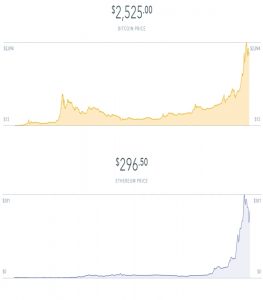
If you bought 25 dollars worth of bitcoins in 2010, you would now enjoy over 60 million dollars. But knowing the history behind bitcoin, is it still worth investing in? Or should potential investors buy Ethereum?
In 2009 something was happening on the currency market that caused traditional investors to burst out in laughter. A new currency called Bitcoin suddenly appeared from the internet’s digital depth. Not only did the currency not exist in physical form – nobody knew who created it, or who exactly had control over it.
Who in the world could take this seriously?
In the beginning, it was only IT-nerds that used the currency, and one of the first physical purchases was a 2-pizza order from Papa John’s, costing 10 000 Bitcoins. That was in 2010.
| At eToro you can trade 49 currency pairs, including several cryptocurrencies. Join eToro |
Now things have turned in favour of this new payments unit, and it has been gaining speed. The Internet needed a currency that was more free and flexible than traditional currencies, and at the same time could move freely between borders. Perhaps Bitcoin was actually part of the answer?
The digital coins were collectively termed cryptocurrencies, you may want to look these up or research thoroughly, if a more comprehensive understanding of how you could invest in them is desired. Then in 2010 the first Bitcoin exchange, MtGox, was established the same year as the pizza purchase. Suddenly, Bitcoin had an official value and was open for trade and investment.
Back then 10 000 Bitcoins were worth roughly 40 USD. Today – eight years after the infamous pizza purchase – the same amount of Bitcoin is now worth around 100 million dollars. Price developments have, at the very least, caused the laughter to die down among traditional investors. And today the cryptocurrency is seen as an important part of the internet’s future.
Now the question is simply: how and which cryptocurrency will enter the big leagues? These questions are absolutely essential if you’re considering investing in cryptocurrencies mid-and long-term.
Cryptocurrency is a collective term for alternative currencies such as Bitcoin, Ether, Litecoin, and many others. The majority is based on blockchain-technology, and there are currently over 1600 digital currencies.
 What is a cryptocurrency?
What is a cryptocurrency?
Both Ether and Bitcoin are so-called cryptocurrencies. Today, there are over 1600 digital currencies, and most of them share a basis in the so-called blockchain technology. This means that payments are validated by a network of computers, and a middleman such as a bank or a card issuer such as Visa is no longer necessary. This lack of middlemen makes digital currencies particularly flexible. For more information on trading options, look up various blogs and articles (similar to https://www.coin.cloud/buy-online) to get a substantial idea before any making an investment.
Out of 1600 digital currencies, only two that could be considered widely accepted. They are Bitcoin, with a gross market value of over 156 billion, and Ethereum (also called Ether) with a market cap of over 70 billion dollars. But there are others on the way.
Moreover, there is a rich underpinning of other cryptocurrencies that are discussed and hyped on a regular basis. Risk-prone traders are regularly throwing money at it in hopes of hitting the new Bitcoin that can rise with the same hectic growth as the original product. LiteCoin and Ripple should be mentioned here as well, along with bubbles such as Dash and Zcash.
Every digital currency has its own technical features that according to its developers and investors will pave the way for their “coin” to become the digital currency of the future.
In this article, we will focus on the analysis of investment possibilities in the two biggest cryptocurrencies, Bitcoin and Ethereum respectively. What is the potential and what are the risks of these two cryptocurrencies?
| At eToro you can trade 49 currency pairs, including several cryptocurrencies. Join eToro |
Basic information
Serious consideration of investment should include data regarding the market value (market cap), trading volume, and distribution. For Bitcoin and Ethereum the data is as follows (as of 3rd of May, 2018):
Bitcoin: Market cap: $156,661,097,565, volume: $8,037,130,000
Ethereum: Market cap: $71,018,150,967, volume: $3,075,700,000
This shows that Bitcoin’s and Ethereum’s combined value is higher than most businesses in the world, apart from a few exceptions.
You can see updated data here.
As to the distribution of Bitcoins, the currency has already been accepted as a payment in hundreds of international companies. These include fast food chain Subway, tech companies like Dell and Microsoft, and e-shops like Shopify. Moreover, Japan has approved Bitcoin as money, as thousands of Japanese business – at least officially – accept Bitcoin.
In regard to Ethereum and the associated currency Ether, it is almost as widespread as money. On the other hand, the project around Ethereum (as a technology) has been embraced by companies such as J.P. Morgan, Credit Suisse, Accenture, Deloitte, UBS, the International Bank of Canada, and a handful of other big multinational businesses that joined the so-called Enterprise Ethereum Alliance, which has the goal of spreading, developing, and maturing the technology around Ethereum.
At the same time more and more private investment funds are emerging that are fully or partially exposed to both Ethereum and Bitcoins.

The technology
In order to assess the value and the potential of buying Ethereum and Bitcoins, it is necessary to look at the underlying technology. Both currencies rely on the so-called blockchain technology, which is described here. There are significant differences between the two currencies that should be noted:
Bitcoin was created from the beginning as a kind of digital gold. Developers wanted a trustworthy monetary system in line with recognised currencies, but free from inflation, borders, and political intervention. From the start, the goal was to have a cryptocurrency. The Bitcoin infrastructure allows for only 21 million Bitcoins to exist, and no more can be created. This means that in essence Bitcoin doesn’t have the same risk of inflation as a normal currency. The inventor of Bitcoin is anonymous, known only as Satoshi Nakamoto, who published his idea in 2008 and later in 2009 gave the system away as open source. Satoshi Nakamoto has never been identified.
Ethereum or ether, in contrast, was meant to be more than a currency from the start. The ambition is for Ethereum to evolve into a kind of world computer. A blockchain-based programming language that offers “smart contracts” to the whole world, as well as decentralised applications that can work on their own, for example in combination with artificial intelligence.
Ethereum also offers a cryptocurrency, that is not in fact called Ethereum, but simply Ether. The Ethereum protocol has been invented by a programmer Vitalik Buterin in 2014 and started through an online crowd sale in the summer that same year.
The supporters of Ethereum believe that Ether can be perceived as a further evolution of Bitcoin, and therefore slowly, but surely, it will beat the “old” virtual currencies. Among other differences, Ethereum is written in a computer language that is more compatible compared to Bitcoin. The language means, among other things, that new Ether coins can be created much quicker than Bitcoin. Ether’s inflation can change over time, as the system is still under development. Most expect the inflation to be around 1-2% a year.
You can read more about the technology in the article Bitcoin in 5 minutes.
Bitcoin advantages:
– Already known and widespread
– No inflation
– Only a digital currency
– Higher security due to its simplicity
Ethereum advantages:
– Advanced blockchain that can be extended
– Turing-compatible computer language
– Quick transfer
Immediately it might be seen as a small feat for Ethereum to beat Bitcoin in the long-term, but it is not so easy. Ethereum system’s openness towards “smart contracts” and external applications also leaves the Ethereum engine vulnerable to attack. A big cyber attack can cause companies to lose trust in Ethereum, and decimate the value of it.
Bitcoin is also facing some built-in challenges in the original code, which makes the system slower, and slower. At the same time, many experts are concerned that a big part of “mining” new Bitcoins takes place in huge server-farms in China. In theory, there is a risk that China can block a number of Bitcoin accounts. In addition, China may be able to fully ban the use of Bitcoins. This would remove a large part of the market, and thereby probably crash the value of the cryptocurrency.
 Exchanges
Exchanges
There is a risk in front of every potential investor in both Bitcoin and Ethereum, as crypto-exchanges, where cryptocurrency trading takes place, seem particularly unsafe. Multiple exchanges have been exposed to devastating attacks. Most people are aware of the attack on the Japanese Bitcoin exchange Mt.Gox in 2014, where over 600.000 Bitcoins were stolen or lost.
Many experts have warned that cryptocurrency exchanges are not centralised or sufficiently regulated. This means that there are easy victims of wild speculation or extreme psychological mechanisms.
“Whereas reputable stock exchanges, such as the NYSE, have machine-assisted trading tools and tens of millions of people and institutions investing daily, bitcoin and Ethereum’s trading platforms aren’t centralized, nor are there institutions “making a market” in these digital currencies. A more thinly traded environment allows momentum and emotion to take form much easier than in the stock market” wrote fool.com, the big American investment site.
That risk was largely illustrated in June 2017, when an Ethereum trading war on the Gdax exchange has caused the price of purchasing Ethereum to drop from 319 USD to 10 cents in a split second. However, the fall could not be seen on other exchanges that traded in cryptocurrencies.
Therefore, if you’re thinking of investing in a cryptocurrency, be prepared to take on significant risk. On the other hand, the developments in the upward direction can prove to be at least as explosive, if one of the two currencies finds a serious place in the society.
Cryptocurrencies are still in their early stages, and the majority of the world’s population doesn’t know they exist. It is therefore close to impossible to predict price developments, as they may be suddenly changed by a breakthrough.
| At eToro you can trade 49 currency pairs, including several cryptocurrencies. Join eToro |
Which price developments can be expected?
Several business universities have tried to predict price trends, but every time the research ends with the expectation of relatively moderate price increases. This is due to the fact that it is impossible to predict what will happen if there is a genuine breakthrough for one of the many cryptocurrencies. The report “Bitcoin or Ethereum – The Million Dollar Question” from Johns Hopkins Carey Business School concludes that both Bitcoin and Ethereum can expect a roughly 100% rise over the next 5 years.
A 2016 report “Ethereum vs. Bitcoins” from Creighton University also illustrates how hard it can be to predict developments. In this instance, the researchers calculate the price of Ethereum at 367 USD after around 4 years. However, that price was already reached in the summer of 2017. Currently, Ethereum trades at double that price – 734 USD (as of 3rd of May, 2018).
Kraken, the digital exchange, has joined the Economist in 2016 in an investment case study to investigate which digital currency was considered the most promising, Ethereum or Bitcoin. The question was put before a number of universities, and the assignments were as follows:
“You have one million dollars that can be invested in ether or bitcoin. You cannot touch the investment in the next 5 years. How do you invest and why?”
Thirteen American universities took the assignment seriously and studied the two currencies against a long list of criteria. One university did not want to invest in either ether or bitcoins. Another one would put almost all the funds into bitcoins, and yet another one would instead invest in Ethereum. Overall the results reflected investing 55% of the portfolio in bitcoin, and the rest (45%) in Ether.
| At eToro you can trade 49 currency pairs, including several cryptocurrencies. Join eToro |
Co-creator of Ethereum, Steven Nerayoff, has predicted that the value of this cryptocurrency would triple this year, partly due to the fact that various industries are beginning to see the potential of the ethereum protocol. Other Ethereum price predictions for the coming years include 14.000 USD in 2019, and around 31.000 USD by the end if 2020. The numbers aren’t pulled from the sky – Ethereum is currently enjoying steady adoption. Smart contracts are becoming increasingly popular, many companies implement decentralised cloud-based applications, and there are more application uses.
Bitcoin’s predictions look no less optimistic, and even more volatile. Some may seem too optimistic, with some predictions of 100 000 USD by the end of 2018. But the predictions vary from 100 USD to 25k, 40k, 50k, or higher, depending you ask.
If you’re still not sure which one you should invest in, you can find forecasts based on technical analysis here. Based on current price, it is predicted that Ethereum will reach 1488 USD in a year, and 4152 USD in 5 years. Bitcoin’s price is predicted to be 18.943 USD and 56.127 USD in one and five years respectively.
Want to trade your own cryptos?
If you want to own coins yourself, you can speculate on the price with for example eToro trading platform. There, you have the possibility to buy Bitcoin, Ethereum, LiteCoin, and Ripple. You can read our review of eToro here. It may also be a good idea to join a few relevant Facebook groups in order to stay updated.










